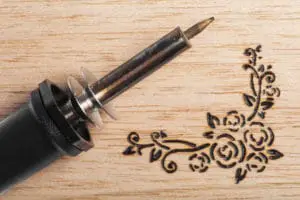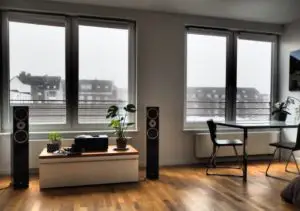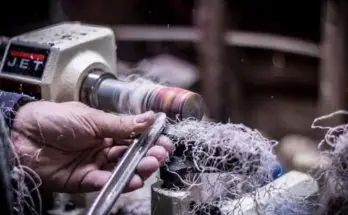Creating with wood is a wonderfully satisfying hobby, but it does not require an enormous setup. With proper planning and selective focus, your woodworking skills can thrive in the smallest of living spaces.
To succeed with your woodworking projects, you need to plan your space carefully, use the space wisely, and clean the space thoroughly. You need to be realistic in the scope and scale of your projects.
You need to start small, think minimal, and grow your woodshop with the essential tools and material. And let me say it again: this is where you live, so always clean up after yourself!
Plan Your Space Carefully
There are 3 major things you need to consider when deciding to do woodworking in your apartment. Those three items are 1) Noise 2) Dust 3) Vapor/odors.
It’s extremely important to control these three areas as much as possible to ensure you don’t upset your landlord or neighbors.
Noise
Noise complaints are probably the most common complaint from tenants. No one wants to live next to someone who isn’t respectful of others living around them. There are plenty of steps you can take to avoid any noise complaints. In fact, it you make noise control a priority, you can likely do some woodworking without anyone knowing.
The biggest impact that you can make around noise control is choosing the correct tools. Setting up a large table saw in your apartment just isn’t feasible. However, there are many different areas within the woodworking realm. Woodworking areas such as pyrography and wood carving are perfect for woodworkers living in an apartment. Both of these areas require small hand tools and have no noise associated with them at all.
If you are interested in learning about wood carving, check out this article I wrote to get you started!
If you decided you these areas aren’t for you, then you can take a look at woodworking with hand tools. Rather than buying power tools, you can pick up a wide variety of hand tools to help control the noise levels. Using a hand saw to cut a board will be more time consuming, but it will give you some additional exercise and likely keep you from getting any noise complaints.
You can buy many different types of handsaws as well as planers and even drills if you like. The other great thing about using hand tools is

that they are much cheaper. You can build your collection of tools up rather quickly by buying older used parts. Many times, if you search eBay for a “tools lot” you can find several tools in one auction. These tools might need to be cleaned up and have the blades replaced, but I think this is great experience for a new woodworker. It’s important to understand how your tools work.
An additional step you can take to control noise is to hang acoustic blocks on the walls surrounding your work area. You really only have to focus on the shared walls and possibly the ceiling if you have people living above you. You can pick up acoustic panels for about $1 per square foot. I’ve had good success using this particular set (Amazon Link) for other projects around the house.
Another thing you can do is buy some noise cancelling curtains and hang them on the walls that are shared with neighbors. These thick curtains help muffle sounds. This set of curtains on Amazon has excellent reviews and is well priced.
Dust
Dust is a big concern when working in an apartment. Not just in terms of keeping your place clean, but it’s also a safety concern. Breathing saw dust over an extended period of time can cause cancer.
Trying setup your work area near a window can help significantly with dust and also the odor concern. Ideally, your woodworking shop will have adequate air flow and good light. An open window with a box fan facing out provides nice air circulation to give yourself one layer of protection from sawdust and paint fumes.
If you are going to be sanding or cutting wood, I highly suggest that you also wear a mask to filter out the dust. Mask can run anywhere from a few bucks to upwards of $100. I really like this particular mask from Trend (Amazon Link) because it is very lightweight and does an excellent job of filtering out dust particles.
Odor
Controling the odor from your woodworking, will really depend on what the odor is coming from and how strong it is. If you are using a paint thinner or something that has very strong fumes, I’d suggest taking the boards downstairs and painting them in a common area (if it is allowed by your lease).
Other times though, it is entirely possible to control the fumes by just opening a window an/or turning a fan on.
Layout
In my opinion, it’s important to create a separate space dedicated to your woodworking hobby. You need a dedicated workbench in your shop. Not your kitchen table or an old computer desk made from ½” pressboard, but a solid, flat surface with four sturdy legs.
It could be your first project: a 2×4- framed table with shelving underneath and a ¾” AC ply lid. Something on which you can scribble, hammer, screw, and stain. Remember the lid is temporary; don’t think of it as a piece of furniture. The more work you do, the sooner you will need to replace it.
Think of your woodshop as a camper or a Japanese capsule hotel room. Items are hidden compactly in inventive nooks and crannies. Surfaces and storage units fold out for easy access, then flip out of the way until needed again. Your workbench becomes an Inspector Gadget command center for your woodshop.
Tools can hang off the sides, a shop-vac can live underneath. (More on the shop-vac later.) A bench vise mounted on one corner. A towel bar mounted on the other side.
I love the look of a well-organized pegboard for tools; it reminds me of a map to a city. But unless you have a bare wall screaming for attention in your apartment, you should plan on a tool chest with gliding drawers. My favorite work areas have been when I’ve built my own storage shelves and hardware boxes.
Can’t find a small chest that holds a standard 24” carpenter’s square? Build it yourself! But what to put in those drawers and shelves?
Use Your Space Wisely
The French have a phrase for cooking in the kitchen, mise en place, that means “everything in its place.” You don’t have a lot of room to spare in your apartment-sized woodshop. Like a skilled chef, plan your space like you’re preparing an elaborate recipe.
Know what tools you’ll use, how much of each ingredient you need, and keep them all handy. You won’t have the luxury of buying in bulk unless you plan on getting rid of all your furniture.
Start with the minimum. Avoid buying every gadget a full-sized shop houses; the last thing you want is a bunch of unitaskers: tools that only do one job and that you’ll only use once a year. As chef and TV host Alton Brown says: “The only unitasker allowed in my kitchen is a fire extinguisher.” (Good idea: invest in a pressurized water fire extinguisher for your woodshop.)
 Think about what tools will you use every day. What jobs will you perform every day for your projects? Do you really need a 148-piece socket set? Likewise, what hardware will you use every day? How much glue will you need in a week? Keep your supply of expendables to a minimum so your shop doesn’t take over your entire living space.
Think about what tools will you use every day. What jobs will you perform every day for your projects? Do you really need a 148-piece socket set? Likewise, what hardware will you use every day? How much glue will you need in a week? Keep your supply of expendables to a minimum so your shop doesn’t take over your entire living space.
And keep your supplies separate from your household supplies in small drawers, mason jars, or Tupperware bowls. You should plan a secondary tabletop surface as your sawing area, and once again, starting minimally is the key to a successful layout.
What one saw can handle most of your cutting needs? Are you cutting hardwoods or veneers, and what thicknesses? A benchtop bandsaw (like this one) with a sliding rip fence, or a miter saw? How many curves will you be cutting? Ideally, this saw meets all your demands, while fitting into your workshop space.
Don’t forget about a bright overhead lighting fixture, even when working during sunlit days. A single pendant lamp over your workbench works better than an articulated arm lamp mounted on the bench itself. I’ve seen too many light bulbs rattled to death by the pounding and vibrations on a workbench. Keep the light source separate and out of your way.
Clean Your Space Thoroughly
By definition, you’re establishing an apartment-sized woodshop because you don’t have access to a garage or basement or backyard shed. If you have a spare bedroom, then great, slam the door and seal off your dedicated woodshop. Otherwise, keep in mind that you (and your loved ones) will be living in the airspace and sight lines of your hobby area.
Tools need a place to live when not in use. Material needs to store away. Hardware needs to be sorted and stowed. The space needs to, as my Mom would say, “clean up real good.” Enter the necessity of a good shop-vac. Running a shop-vac during your work is just as important as to clean up dust and debris after your work.
My wife loves the smell of fresh-cut wood on me when I come home from work, but she never learned to appreciate the Pigpen-like cloud of sawdust that plumed off my clothes at dinnertime. You want to keep the floor and tabletops clean, but you need to consider the air in the room as well. Avoid a layer of sawdust coating all the furniture and lampshades by running the shopvac as you create the dust.
Your average shop-vac runs at about 75-80 decibels (dB), which is fairly loud. A lawnmower runs at about 90 dB, while a bandsaw tops at about 105 dB. Keep your neighbors happy by running the shop-vac and power tools during the day. Keep your shop-vac happy by cleaning the filter regularly; built-up dirt makes the fan work harder and noisier.
Dedicate a safe, out-of-the-way space for oil-based stains and cleaners in a rated, flame retardant cabinet. It will keep fumes and vapors to a  minimum, and most importantly, it keeps harmful material under lock and key. Think about the idea of the camper again. You got to sleep where you eat. Be Practical with Projects
minimum, and most importantly, it keeps harmful material under lock and key. Think about the idea of the camper again. You got to sleep where you eat. Be Practical with Projects
I once taught at a school that built a new common space for students. Before the room was finished, two large frames were installed on opposite walls housing a pair of beautiful prints commissioned by a local artist. The prints were 12’ tall by 24’ wide, and the frames were constructed in place.
After the drywall and windows and doors were installed, the school realized there was no way to ever remove the frames intact. The prints had become permanent fixtures in the assembly room. As you build in your apartment-sized woodshop, remember those framed prints in the school. Keep your projects manageable, like you’ve done with your inventory.
Wood-burning, hand-carving, furniture restoration, wood mosaic assembly are all viable small-scale hobbies that produce beautiful creations.
Conversely, think about the raw materials that you’ll need to enter your workspace. What can you bring up the stairwell and through the front door? What can you store safely and compactly in your woodshop? Board lumber or sheet goods? Are you working with found objects or repurposed wood; are you reupholstering with batting and bolts of fabric? Not only would you like to share your products with the world outside your door, but you got to get the stuff in the door to start.
Woodworking in an apartment takes planning and a dedication to keeping things neat and simple. Plan the space, use the space, clean the space! You don’t need an enormous amount of room.
As TV personality Martha Stewart says about the use of space: “The homes I like the best are totally occupied, busy, and useful, whether it’s a tiny little house or a great big one. Rarely do you find a great big house that’s used in a good way. So I prefer smaller spaces that are … full of things that people are doing.” That vision should be the goal and the pleasure of your apartment-sized woodshop.




